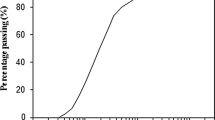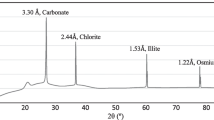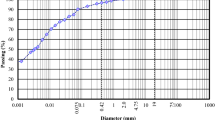Abstract
Soil stabilization using lime has been long used to improve geotechnical characteristics of soil for civil engineering purposes. Unlike lime, as far as known to the authors, there is no specific research for soil improvement by zero-valent iron. In this study nanoscale zero-valent iron (NZVI) particles and nanoscale hydrated lime (NHL) have been used to determine their effects on Atterberg limits, compaction properties, unconfined compressive strength (UCS) and shear strength parameters (c and ϕ) of a gas oil contaminated clay soil. To determine the optimal reaction time and NZVI dosage, percent of total organic carbon in the contaminated soil with 9 % of gas oil was measured. From experimental data, optimum reaction time and NZVI dosage were 24 days and 5 %, respectively. Then, the contaminated samples were prepared by mixing the soil with gas oil in amounts of 0, 3, 6 and 9 % by dry weight. The results showed a decrease in UCS, maximum dry density, optimum moisture content and internal friction angle and an increase in liquid limit (LL), plastic limit (PL) and cohesion. Finally, all contaminated specimens were mixed with 5 % of NZVI. After 24 days an increase in UCS, maximum dry density, optimum water content and shear strength parameters was seen. In addition, a decrease in LL and PL was observed. On the other hand, adding 5 % of NHL to the contaminated soil increased UCS, shear strength parameters, LL, PL, optimum moisture content and decreased plasticity index and maximum dry density of the soil after 24 days.



















Similar content being viewed by others
References
Akoto BKA, Singh G (1981) Some geotechnical properties of a lime-stabilized laterite containing a high proportion of aluminum oxide. Eng Geol 34:185–199
Al-Mukhtar M, Khattab S, Alcover JF (2012) Microstructure and geotechnical properties of lime-treated expansive clayey soil. Eng Geol 139–14:17–27
Al-Sanad HA, Eid WK, Ismael NF (1995) Geotechnical properties of oil-contaminated Kuwaiti sand. J Geotech Eng 121:407–412
American Society for Testing and Materials D2166) 1999 (Standard test method for unconfined compressive strength of cohesive soils. Annual Books of ASTM Standards
American Society for Testing and Materials D3080 (1999) Standard test method for direct shear test of soils under consolidated drained conditions. Annual Books of ASTM Standards
American Society for Testing and Materials D422 (1999) Standard test method for particle size analysis of soils. Annual Books of ASTM Standards
American Society for Testing and Materials D4318 (1999) Standard test method for liquid limit, plastic limit and plasticity index of soils. Annual Books of ASTM Standards
American Society for Testing and Materials D4972 (1999) Standard test method for pH of soils. Annual Books of ASTM Standards
American Society for Testing and Materials D698 (1999) Standard test method for laboratory compaction characteristic. Annual Books of ASTM Standards
American Society for Testing and Materials D854 (1999) Standard test method for specific gravity of soils. Annual Books of ASTM Standards
Bell FG (1996) Lime stabilization of clay minerals and soils. Eng Geol 42:223–237
Bhatt I, Tripathi BN (2011) Interaction of engineered nanoparticles with various components of the environment and possible strategies for their assessment. Chemosphere 82:308–317
Boardman DI, Glendinning S, Rogers CDF (2001) Development of stabilization and solidification in lime-clay mixes. Geotechnique 51(6):533–543
Brunauer S, Emmett PH, Teller E (1938) Adsorption of gases in multimolecular layers. J Am Chem Soc 60:309–319
Carter DL, Heilman MD, Gonzalez CL (1965) Ethylene glycol monoethyl ether for determining surface area of silicate minerals. Soil Sci Plant Nutr 100:356–360
Chang MC, Shu HY, Hsieh WP, Wang MC (2005) Using nanoscale zero-valent iron for the remediation of polycyclic aromatic hydrocarbons contaminated soil. J Air Waste Manag Assoc 55:1200–1207
Clare KE, Cruchley AE (1957) Laboratory experiments in the stabilization of clays with hydrated lime. Geotechnique 17:97–111
Consoli NC, Lopes LS, Heineck KS (2009) Key parameters for the strength control of lime stabilized soils. J Mater Civil Eng ASCE 21:210–216
Craig RF (1990) Soil mechanics. Chapman and Hall, London
Croft JB (1964) The processes involved in the lime stabilization of clay soils. Proc Aust Road Res Board 2(2):1169–1203
Das BM (1994) Principle of geotechnical engineering. PWS Publishing Company, Boston
De Silva MS, O’Riordan NJ, Parry LN (2001) Trials for the construction of cement solidified retaining structure in a domestic landfill site using deep soil mixing. Eng Geol 60(1–4):49–60
Diamond S, Kinter EB (1965) Mechanisms of soil-lime stabilization—an interpretative review. Highway Res Rec 92:83–102
Diamond S, White JL, Dolch WL (1964) Transformations of clay minerals by calcium hydroxide attack. In: Proceedings of the 12th national conference on clays and clay minerals, Atlanta, pp 359–379
Ghobadi MH, Abdilor Y, Babazadeh R (2014) Stabilization of clay soils using lime and effect of pH variations on shear strength parameters. Bull Eng Geol Environ 73:611–619
Gillham RW, O’Hannesin SF (1994) Enhanced degradation of halogenated aliphatics by zero-valent iron. Groundwater 32:958–967
Hausmann MR (1990) Engineering principles of ground modification. McGraw-Hill Publishing Company, New York
Ho C, Handy RL (1963) Characteristics of lime retention by montmorillonitic clays. Highway Res Rec 29:55–69
Joo SH, Feitz AJ, Sedlak DL, Waite TD (2005) Quantification of the oxidizing capacity of nanoparticulate zero-valent iron. Environ Sci Technol 39:1263–1268
Kermani M, Ebadi T (2012) The effect of oil contamination on the geotechnical properties of fine-grained soils. Soil Sediment Contam 21:655–671
Khamehchiyan M, Charkhabi AH, Tajik M (2007) Effect of crude oil contamination on geotechnical properties of clayey and sandy soils. Eng Geol 89:220–229
Khosravi E, Ghasemzadeh H, Sabour MR, Yazdani H (2013) Geotechnical properties of gas oil-contaminated kaolinite. Eng Geol 166:11–16
Lambe TW (1958) The engineering behavior of compacted clay. J Soil Mech Found Div ASCE 84:1–35
Lambe TW, Whitman RV (1969) Soil mechanics. Wiley, New York
Lee J, Kim J, Choi W (2007) Oxidation on zerovalent iron promoted by polyoxometalate as an electron shuttle. Environ Sci Technol 41:3335–3340
Lees G, Abdelkader MO, Hamdani SK (1982) Effects of the clay fraction on some mechanical properties of lime-soil admixture. J Inst Highway Eng 29(11):2–9
Lemaire K, Daneele D, Bonnet S, Legret M (2013) Effects of lime and cement treatment on the physicochemical, microstructural and mechanical characteristics of a plastic silt. Eng Geol 116:225–261
Li AQ, Elliott DW, Zhang WX (2006) Zero-valent iron nanoparticles for abatement of environmental pollutants: materials and engineering aspects. Crit Rev Solid State Mater Sci 31:111–122
Lien HL, Zhang WX (1999) Dechlorination of chlorinated methanes in aqueous solution using nanoscale bimetallic particles. J Environ Eng 125:1042–1047
Little DN (1999) Evaluation of structural properties of lime stabilized soils and aggregates, vol 1. National Lime Association, Arlington
Matheson LJ, Tratnyek PG (1994) Reductive dehalogenation of chlorinated methanes by iron metal. Environ Sci Technol 28:2045–2053
Mckinley JD, Thomas HR, Williams KP, Reid JM (2001) Chemical analysis of contaminated soil strengthened by the addition of lime. Eng Geol 60(1–4):181–192
Meegoda JN, Chen B, Gunasekera SD, Pederson P (1998) Compaction characteristics of contaminated soils-reuse as a road base material. In: Vipulanandan C, Elton DJ (eds) Recycled materials in geotechnical applications. Geotechnical Special Publication ASCE, vol 79, pp 165–209
Moore RK (1987) Lime stabilization: reactions, properties, design and construction. State of the Art Report, No. 5. Transportation Research Board, National Research Council, Washington
Nowack B, Bucheli TD (2007) Occurrence, behavior and effects of nanoparticles in the environment. Environ Pollut 150:5–22
Obuzor GN, Kinuthia JM, Robinson RB (2011) Utilisation of lime activated GGBS to reduce the deleterious effect of flooding on stabilised structural materials: a laboratory simulation. Eng Geol 122(3–4):334–338
Olgun M, Yildiz M (2010) Effect of organic fluids on the geotechnical behavior of a highly plastic clayey soil. Appl Clay Sci 48:615–621
Osula DOA (1991) Lime modification of problem laterite. Eng Geol 30:141–154
Pierce JW, Siegel FR (1969) Quantification in clay mineral studies of sediments and sedimentary rock. J Sediment Petrol 9:187–193
Prashanth JP, Sivapullaiah PV, Sridharan A (2001) Pozzolanic fly ash as a hydraulic barrier in landfills. Eng Geol 60(1–4):245–252
Rahman ZA, Hamzah U, Taha MR, Ithnain NS, Ahmad N (2010) Influence of oil contamination on geotechnical properties of basaltic residual soil. Am J Appl Sci 7:954–961
Rogers CDF, Glendinning S (1996) Modification of clay soils using lime. In: Rogers CDF, Glendinning S, Dixon N (eds) Lime stabilization. Thomas Telford
Schifano V, MacLeod C, Hadlow N, Dudeney R (2007) Evaluation of quicklime mixing for remediation of petroleum contaminated soils. J Hazard Mater 141:395–409
Shah SJ, Shroff-Jignesh AV, Tiwari KC, Ramakrishnan D (2003) Stabilization of fuel oil contaminated soil—a case study. Geotech Geol Eng 21:415–427
Shimizu A, Tokumura M, Nakajima K, Kawase Y (2012) Phenol removal using zero-valent iron powder in the presence of dissolved oxygen: roles of decomposition by the fenton reaction and adsorption/precipitation. J Hazard Mater 201:60–67
Song H, Carraway ER (2005) Reduction of chlorinated ethanes by nanosized zero-valent iron: kinetics, pathways, and effects of reaction conditions. Environ Sci Technol 39:6237–6245
Sridharan A, Rao GV (1979) Shear strength behavior of saturated clays and the role of the effective stress concept. Geotechnique 29:177–193
Tratnyek PG, Johnson RL (2006) Nanotechnology for environmental cleanup. Nanotoday 1:44–48
United Stated Environmental Protection Agency (USEPA) (1992) The superfund innovative technology evaluation program: technology profiles, 5th edn. EPA/540/R-92/077
Varanasi P, Fullana A, Sidhu S (2007) Remediation of PCB contaminated soils using iron nano-particles. Chemosphere 66:1031–1038
Wang CB, Zhang WX (1997) Synthesizing nanoscale iron particles for rapid and complete dechlorination of TCE and PCBs. Environ Sci Technol 31:2154–2156
Zhang WX (2003) Nanoscale iron particles for environmental remediation, an overview. J Nanoparticle Res 5:323–332
Zhang WX, Elliott DW (2006) Application of iron nanoparticles for groundwater remediation. Remediat J 16:7–21
Zhang ZY, Lu M, Zhang ZZ, Xiao M, Zhang M (2012) Dechlorination of short chain chlorinated paraffins by nanoscale zero-valent iron. J Hazard Mater 243:105–111
Zhao D (1996) Experimental study of stress–strain and shear strength behavior of contaminated cohesive soils. Dissertation, The Johns Hopkins University
Author information
Authors and Affiliations
Corresponding author
Rights and permissions
About this article
Cite this article
Nasehi, S.A., Uromeihy, A., Nikudel, M.R. et al. Use of nanoscale zero-valent iron and nanoscale hydrated lime to improve geotechnical properties of gas oil contaminated clay: a comparative study. Environ Earth Sci 75, 733 (2016). https://doi.org/10.1007/s12665-016-5443-6
Received:
Accepted:
Published:
DOI: https://doi.org/10.1007/s12665-016-5443-6




